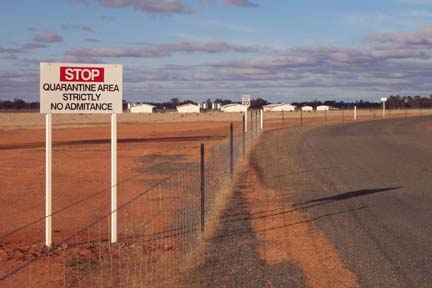PACE Farm Investigation: West Wyalong, NSW July 18, 2002 Modern-day factory farming dictates that animals are forced to live miserable and deprived lives locked in windowless sheds that must be quarantined due to the enormous numbers of animals closely confined. Today’s children do not know what a hen looks like, let alone the cruel conditions they endure. The rescue team spent part of the day filming the proposed location for Pace Farm’s anticipated largest battery hen factory in the Southern Hemisphere (720,000 hens in twelve sheds, each one caging 60,000 birds stacked six tiers high). We took photographs of the Pace Farm pullet rearing factory recently constructed three kilometres away (see photo below). When only a day old, 65 chicks are placed into each metal cage, where they will remain until they reach sexual maturity at the age of 4-5 months. The cages are endlessly stacked in tiers and enclosed in four windowless sheds. The chicks will never ever touch the ground or see the light of day. The lights in these sheds are kept at 5 lux, which is near darkness, to push the pullets into production at 16 weeks. The rescue team did not enter these sheds, but we have absolutely no doubt we would have found many sick and dying baby birds left to slowly suffer til their end. Pace Farm EIS describes the “operational mortality” as “normal attrition”. This figure is put at 6.7% at the end of the normal laying cycle. They go on to state that “the calculated mortality is expected to be approximately 6 birds per shed per day.” In clearer terms this calculates at 26,280 dead birds per laying cycle. It’s important to realise they are not talking about death from old age or accidental causes which would more honestly refer to normal attrition, but these birds are all very young and in their prime of life, making the 6.7% mortality rate extremely high and very cruel considering it can only be connected to the extreme stress and deprivation these birds are subjected to.
|

